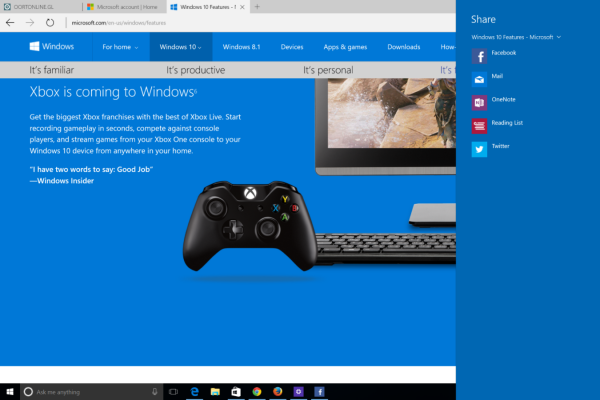Edge vs Internet Explorer: What's New
Microsoft's Internet Explorer browser is so last year. With the introduction of Windows 10, the software giant has changed the default browser that comes with its new operating system and called it Edge. That doesn't mean IE is going away, as it's still around mostly to support specific legacy apps that make use of it. But the two browsers are very different.
That said, Microsoft didn't throw the baby out with the bathwater. Both Edge and IE have tabs, private browsing and search powered by Bing. They both offer similar performance and speed, on such tests as Peacekeeper and SunSpider. Settings, such as privacy and downloads management, are the same in both browsers. But Edge sports a sleeker, more modern aesthetic and has Cortana embedded for easier searching, among some other fancy new features.
MORE: Edge vs. Chrome vs. Firefox: Which Windows 10 Browser Reigns Supreme?
Here's what you need to know about Microsoft's new browser.
Cortana Embedded
Edge brings Microsoft's digital assistant Cortana to the desktop. With this aide at your disposal, you can easily pull up pictures, explanations and search results on any word or link while you're browsing by right-clicking and selecting "Ask Cortana." The information slides in on a panel on the right, so you don't have to leave the page you're on.
When you visit the website of a restaurant, a circle icon appears at the end of the URL with the words, "I've got hours, directions and more." Clicking that circle pulls in the side panel with info from Cortana (via Bing) such as directions, reviews and a shortcut to call and make a reservation. Microsoft says it will implement more Cortana features into Edge to make it more useful.
Internet Explorer has nothing like Cortana embedded. No extra information slides in on a panel — you'll have to open up a whole new tab to learn more about what you're browsing. You can highlight text, right-click it and choose to "Search with Bing," but that's as close as you get. And with Microsoft pouring its development efforts into Edge, don’t expect Cortana features to ever appear in IE.
Sign up to receive The Snapshot, a free special dispatch from Laptop Mag, in your inbox.
Reading mode
Hate seeing ads and superfluous navigational menus when you're reading your favorite articles online? Reading mode on Edge, similar to that on Firefox and Safari, gets rid of distracting links and graphics on Web pages so you can focus on your story.
Internet Explorer 11 (for Windows 8.1) has a similar Reading View, but other versions of IE don't. That's even true of IE11 for Windows 10. None of the nearly 30 official add-ons available for Internet Explorer offer something like this.
Mark up pages in Web Note
Another new Edge feature is the ability to turn the page you're viewing into a canvas for your scribbles and doodles. Show your partner the couch you want from Amazon, or highlight part of your purchase history to someone. You can export the page as an image and share it with your friends via Mail.
To do this in Internet Explorer, you'd need to take a screenshot, open it in Paint or OneNote, make your doodles and then save to share.
Easier sharing
With the built-in Share button on Edge's navigational bar, you can now easily send pages to your friends. Edge will pull up the installed apps that work with the Share feature, such as Facebook, Twitter and Mail, and you can post the links to your social media accounts with one click.
Sharing from Internet Explorer on Windows 8 was simple enough with the Share function in the Charms menu, but on Windows 10, that option is missing. None of the existing add-ons for Internet Explorer add that feature to the old browser.
New first page
Whenever you open a new window or tab, Edge now shows you a selection of top sites, along with a personalized news feed. Best of all, the top of the page features a search/URL bar that asks, "Where to next?" so you can immediately type in a link or query to get going.
By comparison, the Internet Explorer home page brings up a thumbnail grid of your most frequently visited sites and a search bar (powered by Bing). Unlike in Edge, though, you'll have to click in this bar in IE before you start to type; you can immediately start typing in a new Edge screen.
New flat design and look
Internet Explorer has a separate row for the title and minimize, maximize and close buttons, while placing its tabs on the second bar. In contrast, Edge combines the two rows into one to save space. By doing that, Microsoft frees up more room in the second row for a longer URL bar and clean-looking buttons. The overhaul also gives Edge a flatter, more modern and, dare I say it, edgier look.
Extensions
No one thinks of Microsoft's browser as one that has many extensions, but Internet Explorer actually supports add-ons that enhance the browser. These range from Speckie, an in-browser spell checker, to Wikipedia Visual Search for instant results from the online encyclopedia below your URL bar. The selection is limited compared to those available for Chrome and Firefox, since there are just under 30 Internet Explorer add-ons on the browser's official add-on gallery.
With Edge, all that might change. Microsoft has announced that Edge will not only support its own extensions, but will also be compatible with extensions from Chrome and Firefox. The current version of Edge doesn't do this yet, but Microsoft said it expects to bring this feature live in the fall.
Having issues with Windows 10? Tom’s Hardware has a team of community staffers standing by in the forums to answer your questions 24/7. You can also share your own experiences, or jump in and help others.








